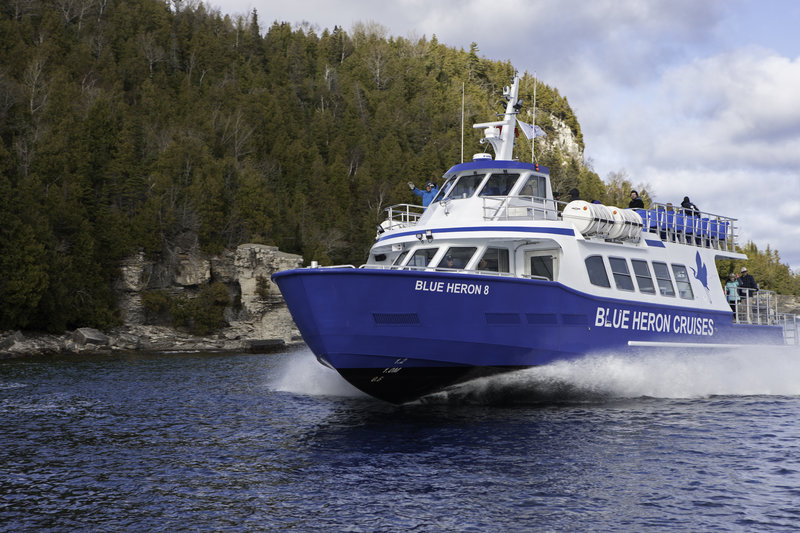MetalCraft Marine, Kingston, Ontario, Canada, delivered the new aluminum 20.08mx7.01mx1.98m (66'x23'x6'6") glass-bottom tour boat Blue Heron 8 to Blue Heron Cruises, Tobermory, Ontario, Canada, in November 2017. Between then and May 2018, the owners prepared the boat for its first tourist season.
Tobermory is a lakeside town that some call “the fresh water SCUBA diving capital of the world.” The peninsula is home to two national parks, multiple nature reserves and is designated by the United Nation’s Educational, Scientific and Cultural Organization (UNESCO) as a UNESCO World Biosphere, a title that recognizes where people and nature coexist in harmony. During the summer months, Tobermory welcomes tourists from Toronto and beyond.
Many of Tobermory’s tourists are attracted to the area’s hiking trails and glass-bottom boat tours that cruise over a selection of the 22 shipwrecks scattered under the area’s clear waters. Blue Heron Cruises is one of the tour companies that offer glass-bottom tours during the peninsula’s busy tourist season, from May to October.
“When people get here, they‘re wowed. It becomes a playground for those who live in the city and an escape from the concrete and skyscrapers,” said Ashley Salen, general manager of Blue Heron Cruises. “Our waters are so deep, so cold and so constantly clear and clean. I always hear people say, ‘I didn’t know we had Caribbean colors in our backyard.’”

The new boat is powered by three MTU 10V 2000 M72 diesel engines. MTU photo
Designed by Bedford, Nova Scotia-based E.Y.E. Marine Consultants, the 125-passenger Blue Heron 8 is powered by three MTU 10V 2000 M72 engines, producing 1,207 hp at 2,250 rpm each. The mains are connected to HamiltonJet Hm 521 waterjets through ZF 2000 marine gears with 1.63:1 reduction ratios. The propulsion package gives the new boat a cruising speed of 22 knots and a top speed of 38 knots. HamiltonJet also supplied the controls and steering system (MECs system). For added maneuverability, the boat was fitted with a Side-Power bowthruster. “The extra horsepower these MTU engines give us help us stay on schedule, especially during busy long weekends. We’re excited we don’t need to overwork an engine while we provide reliable, fast ferry service for our guests,” Salen said.
“Blue Heron 8 runs very, very fast — especially for a boat of this size. It performs like a sports car and still carries 125 passengers. You can really put the hammer down, reach 40 knots, and get out to the island fast — even in inclement weather,” said Steve Peschkoff, key account manager for Wajax, the engine distributor.
Blue Heron Cruises’ ferry routes travel directly past waterfront homes, especially during high season. The company tries to keep a low profile to not disturb their neighbors in this small town. When Blue Heron Cruises began looking at adding a newbuild to its fleet, the cruise company surveyed its local community and neighbors for their input. “We built in feedback from everyone when planning the addition of this vessel,” Salen said. “As a result, we knew our priorities were to select an understated ferry design and to ensure the ferry was powered by quiet but powerful engines.”
The Series 2000 engine is designed to be undetectable in the Blue Heron 8’s passenger lounge and dramatically reduces the noise that carries to the fleet’s waterfront residential neighbors. This significant reduction in noise can be attributed to the pre-engineered rubber isolators on the engines. MTU’s engines in ferries like the Blue Heron 8 are installed on rubber mounts designed specifically for MTU to reduce vibration and noise.
Other features of the new boat include a Furuno electronics suite, Zipwake dynamic trim control, and a fuel capacity of 4,320 liters (1,123 gals.). Blue Heron 8 is Transport Canada certified Near Coastal Class II.
In partnership with Wajax, Blue Heron Cruises’ in-house mechanics ensure the Blue Heron 8 performs optimally and offers exceptional uptime and reliability, both of which contribute to lower lifecycle costs. By working with Wajax and MTU, Blue Heron Cruises found the ideal power solution for its fleet’s newest ferry to bring tourists to Tobermory’s pristine natural wonders, all without disturbing its neighbors.





